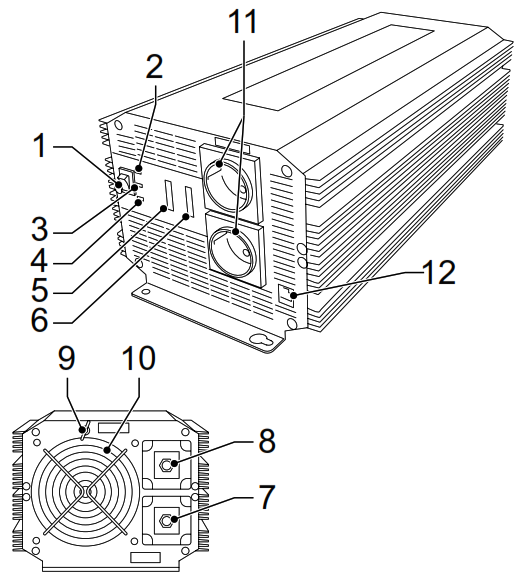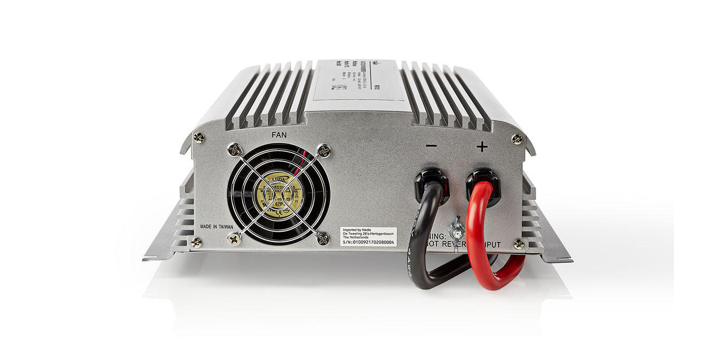 PIMS400012EPower inverter
PIMS400012EPower inverter Description
Description
This is a consumer product that complies with EMI test EN 61000-6-4 class A.This power inverter is a modified sine wave inverter. Modified sine wave inverters are all-purpose power inverters used to power simple electronic devices.
Warning!
Do not use the inverter with the following rechargeable devices:• Only mount in a horizontal position.• Make sure the distance between the battery and inverter is short and only use the provided connection cables.• This product is an inverter with a modified sinewave output. It is not recommended to connect inductive loads and products with an electromotor inside.• Small battery-operated appliances which can be plugged directly into the AC output to recharge (e.g. flashlights, razors, and nightlights).• Certain battery chargers for battery packs used in power tools. These battery chargers will have a warning label stating that dangerous voltages are present at the battery terminals.
| On/off switch | Press the switch to switch the device on or off. |
| Power indicator | The indicator lights green when the device is connected to a battery and switched on. The device is ready for use. |
| Overtemperature indicator | The indicator lights yellow when the device is overheated. An alarm will sound. The device switches off automatically. The device automatically switches on again when it has cooled down sufficiently. |
| Overload indicator | The indicator lights red when the device is overloaded. Switch off the device and reduce the load before switching on the device again. |
| Battery voltage indicator (V) | The indicator shows the voltage at the input terminal of the inverter. |
| Battery current indicator (A) | • The indicator shows the current drawn from the battery by the inverter. The current must be in the green zone for continuous operation. In the yellow zone, the device wil operate for several minutes. In the red zone, the device will switch off automatically. |
| Terminal
7. Positive pole (+, red) 8. Negative pole (-, black) |
Warning!• When connected to a battery, first switch on the inverter before switching on the connected devices. When using the inverter with several appliances at the same time, switch on the devices one after another to make sure that the inverter does not need to deliver all start-up currents for all the loads at once.• Do not reverse the input. Do not use crocodile clips to create an electrical connection. Make sure that the inverter is switched off before connecting the inverter to the battery or other DC power source.• Connect the red battery cable to the positive (+) pole of the battery and the positive (+) terminal of the inverter.• Connect the black battery cable to the negative (-) pole of the battery and the negative (-) terminal of the inverter.• Tighten the screws of the DC input cables regularly. |
| 9. Chassis ground lug | Warning!Do not operate the inverter without connecting the inverter to the ground. Risk of electrical shock. The inverter has a lug to connect the chassis with the inverter. The ground wire in the AC junction box on the output panel of the inverter is connected to the chassis. The chassis ground lug must be connected to a grounding point, which will vary depending on where the inverter is installed.• In a vehicle, connect the chassis ground lug to the chassis of the vehicle.• In a boat, connect the chassis ground lug to the grounding system of the boat.• In a fixed location, connect the chassis ground lug to earth ground by a ground rod (metal rod pounded into the earth). Use a #12 AWG or larger copper wire (preferably with green/yellow insulation ) to connect the chassis ground lug to the grounding point. The neutral conductor of the AC output circuit of the inverter is connected to chassis ground. When the chassis is connected to ground, the neutral conductor will also be grounded. |
| 10. Cooling fan | Wisdom fan start: when the temperature of inverter reach 40°C, the fan will start automatically. |
| 11. AC output | Connect the mains cable of the device to the AC output of the inverter. |
| 12. Remote control jack | The device can be operated using the remote control. |
Audible alarm
An alarm will sound in case of overtemperature, a low battery, or a low-battery shutdown.
Safety
General safety• Read the manual carefully before use. Keep the manual for future reference.• The manufacturer is not liable for consequential damages or for damages to property or persons caused by nonobservance of the safety instructions and improper use of the device.• Only use the device for its intended purposes. Do not use the device for other purposes than described in the manual.• Do not use the device if any part is damaged or defective. If the device is damaged or defective, replace the device immediately.• The device is suitable for indoor use only. Do not use the device outdoors.• The device is suitable for domestic use only. Do not use the device for commercial purposes.• Only use the device in areas with an ambient temperature between 0 °C and 25 °C.• Do not use the device in locations with high humidity, such as bathrooms and swimming pools.• Do not use the device near bathtubs, showers, basins, or other vessels containing water.• Do not use a timer or a separate remote-control system that switches on the device automatically.• Do not cover the device.• Do not block the ventilation openings. Do not insert foreign objects into the ventilation openings.• Keep a clearance of at least 2,5 cm around the device in order to ensure proper cooling and airflow.• Place the device on a stable, flat surface.• Keep the device away from flammable objects.
Electrical safety
 • To reduce risk of electric shock, this product should only be opened by an authorized technician when service is required.• Disconnect the product from the mains socket and other equipment if a problem should occur.• Read the manual carefully before use. Keep the manual for future reference.• Only use the device for its intended purposes. Do not use the device for other purposes than described in the manual.• Do not use the device if any part is damaged or defective. If the device is damaged or defective, replace the device immediately.
• To reduce risk of electric shock, this product should only be opened by an authorized technician when service is required.• Disconnect the product from the mains socket and other equipment if a problem should occur.• Read the manual carefully before use. Keep the manual for future reference.• Only use the device for its intended purposes. Do not use the device for other purposes than described in the manual.• Do not use the device if any part is damaged or defective. If the device is damaged or defective, replace the device immediately.
Cleaning and maintenance
Warning!• Do not use cleaning solvents or abrasives.• Do not clean the inside of the device.• Do not attempt to repair the device. If the device does not operate correctly, replace it with a new device• Clean the outside of the device using a soft, damp cloth.• Clean the ventilation openings using a soft brush.
Support
If you need further help or have comments or suggestions please visit www.nedis.com/support
Contact
NEDIS B.V., De Tweeling 28, 5215 MC ‘s-Hertogenbosch, The Netherlands
References
[xyz-ips snippet=”download-snippet”]

